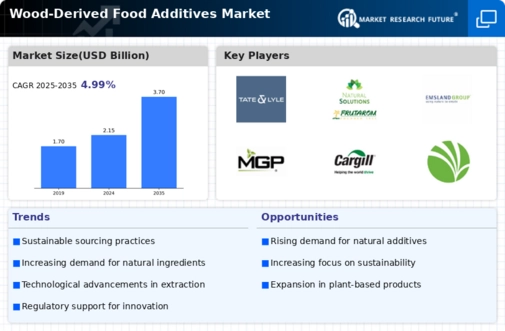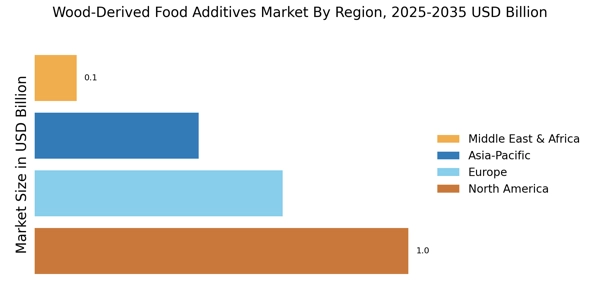Regulatory Support
Regulatory support is emerging as a significant driver for the Wood-Derived food additives Market. Governments and regulatory bodies are increasingly recognizing the benefits of natural food additives, including those derived from wood. This recognition is leading to the establishment of favorable regulations that promote the use of wood-derived ingredients in food products. For instance, certain jurisdictions are implementing guidelines that encourage the substitution of synthetic additives with natural alternatives, thereby bolstering the market for wood-derived options. The alignment of regulatory frameworks with consumer preferences for natural ingredients is likely to enhance the credibility and acceptance of wood-derived food additives. Consequently, this supportive regulatory environment is expected to stimulate growth in the Wood-Derived Food Additives Market, as manufacturers seek to comply with evolving standards.
Technological Innovations
Technological innovations are playing a pivotal role in shaping the Wood-Derived Food Additives Market. Advances in extraction and processing technologies are enabling manufacturers to efficiently produce high-quality wood-derived additives. These innovations not only enhance the yield and purity of the additives but also reduce production costs, making them more competitive against traditional options. The integration of biotechnology in the production process is particularly noteworthy, as it allows for the development of customized additives tailored to specific food applications. As a result, the market is witnessing an influx of innovative wood-derived products that meet diverse consumer needs. This technological progress is expected to propel the Wood-Derived Food Additives Market forward, fostering a more dynamic and responsive market environment.
Health and Wellness Trends
The Wood-Derived Food Additives Market is experiencing a surge in demand due to the rising health and wellness trends among consumers. As individuals become more health-conscious, there is an increasing preference for natural and organic food additives. Wood-derived options, often perceived as healthier alternatives, are gaining traction in various food products. Market data indicates that the demand for natural food additives is expected to increase by 7% annually, reflecting a shift away from artificial ingredients. This trend is compelling manufacturers to innovate and develop wood-derived additives that cater to health-conscious consumers. The emphasis on clean label products is likely to drive growth in the Wood-Derived Food Additives Market, as companies strive to meet consumer expectations for transparency and quality.
Sustainability Initiatives
The Wood-Derived Food Additives Market is increasingly influenced by sustainability initiatives. As consumers become more environmentally conscious, there is a growing demand for food additives sourced from renewable materials. This shift is prompting manufacturers to explore wood-derived options, which are perceived as more sustainable compared to synthetic alternatives. The market for wood-derived food additives is projected to grow at a compound annual growth rate of approximately 5% over the next few years, driven by this sustainability trend. Companies are investing in sustainable sourcing practices, which not only enhance their brand image but also align with regulatory requirements aimed at reducing environmental impact. This focus on sustainability is likely to reshape the competitive landscape of the Wood-Derived Food Additives Market, as businesses that prioritize eco-friendly practices may gain a competitive edge.
Consumer Awareness and Education
Consumer awareness and education are critical factors influencing the Wood-Derived Food Additives Market. As consumers become more informed about food ingredients, there is a growing demand for transparency regarding the sources and benefits of food additives. Educational initiatives aimed at highlighting the advantages of wood-derived additives, such as their natural origins and potential health benefits, are gaining momentum. This increased awareness is likely to drive consumer preference towards products that incorporate wood-derived ingredients. Market Research Future suggests that brands that effectively communicate the value of their wood-derived additives may experience enhanced customer loyalty and market share. Therefore, fostering consumer understanding is essential for the continued growth of the Wood-Derived Food Additives Market, as it aligns with the broader trend of informed consumerism.


















Leave a Comment